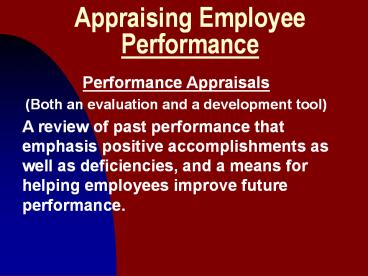Appraising Employee Performance - PowerPoint PPT Presentation
Title:
Appraising Employee Performance
Description:
Appraising Employee Performance ... Informally, performance reviews should be conducted on a day-to-day basis with ongoing feedback from the supervisor. – PowerPoint PPT presentation
Number of Views:2049
Avg rating:3.0/5.0
Title: Appraising Employee Performance
1
Appraising Employee Performance
- Performance Appraisals
- (Both an evaluation and a development tool)
- A review of past performance that emphasis
positive accomplishments as well as deficiencies,
and a means for helping employees improve future
performance.
2
Performance Appraisals
- Traditionally used as a key determinate in pay
and promotion decisions. - And viewed frequently from the Employee
perspective with fear and loathing.
3
Performance Appraisals
- Appraisals should occur on a Formal basis at
least once a year with semi-annual reviews
recommended as a better practice. - Informally, performance reviews should be
conducted on a day-to-day basis with ongoing
feedback from the supervisor.
4
Who Evaluates
- Most employees performance appraisals are
conducted by supervisors. But usually not alone. - Additional input is often obtained from Peers,
Customers, Subordinates, and it is not uncommon
to solicit a self-evaluation from the incumbent.
5
What Processes are Used
- Most companies tend to standardize some some
appraisal procedures in order to ensure that EEO
requirements are met. - The consequence is that supervisors have limited
discretion in evaluating employees. The process
in place will in large part dictate what and how
the performance appraisal data is reported and
managed.
6
Who Sets Expectations
- Supervisors
- Incumbents
- Job Descriptions
- Organizational Goals and
- Objectives
7
Performance Feedback
- Generally feedback comes in two forms
- Intrinsic Self-generated.
- Extrinsic Provided by an outside
- source.
8
Legal Issues
- Performance appraisal policies and procedures, as
set forth in employee handbooks, are being
increasingly construed by the courts as binding
unilateral contracts.
9
Legal Issues
- Supervisors must do everything possible to avoid
the appearance of prejudice and discrimination. - The appraisal criteria, methods, and
documentation must be designed to ensure that
they are job related.
10
Appraising Appropriate Criteria
- Individual Task Outcomes
- At the end of the day what have you
accomplished. - Behaviors
- How does one go about doing their tasks.
- Traits
- How does one appear to be.
11
Performance Appraisal Methods
- Absolute Standard Methods
- Written Essay
- Critical Incident
- Checklists
- Graphic Rating Scales
- Behaviorally-Anchored Rating Scale
12
Performance Appraisal Methods
- Relative Standard Methods
- Group Order Ranking
- Individual Ranking
- Objectives Method
- MBO
13
Performance Appraisal Problems
- Leniency Error positive or negative leniency
that over or understates performance, giving an
individual a higher or lower appraisal than
deserved. - Halo Error a tendency to rate an individual
high or low on all factors due to the impression
of a high or low rating on some specific factor.
14
Performance Appraisal Problems
- Similarity Error rating others in a way that
gives special consideration to qualities that
appraisers perceive in themselves. - Recency Error rating others in a way that
appraisers recall and give greater importance to
employee job behaviors that have occurred near
the end of the performance measuring period.
15
Performance Appraisal Problems
- Central Tendency Error appraisers tendency to
avoid the excellent category as well as the
unacceptable category and assign all ratings
around the average or midpoint range. - Inflationary Pressure a tendency for evaluators
to be less rigorous and to reduce the negative
repercussions from the appraisal process by
generally inflation or upgrading evaluations.
16
Overcoming the Hurdles
- Continually document performance
- Use behaviorally based measures
- Combine absolute and relative
- standards
- Use multiple raters
- Rate selectively
- Participate in appraisal training
17
Team Appraisals
- Peer evaluations by team members is a helpful
adjunct to the supervisors rating. - And
- Supervisors should consider the benefit of
downplaying individual contributions by
substituting Group performance measures.
18
Performance Counseling
- 360 degree feedback
- Discuss performance strengths and
- weaknesses
- Identify development needs
- Redefine goals and objectives
- Establish an action plan
- Act ethically































